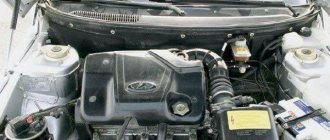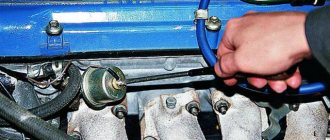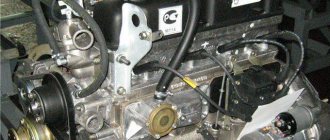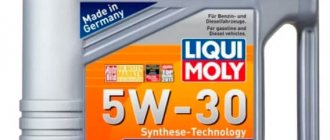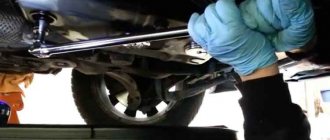Suitable oil according to Nissan Tiida approval
Original oil
Nissan Tiida engine oil is selected based on the temperature outside the car. In winter, lubricants should be thinner than in summer. It is better to purchase original oil from a well-known Japanese company in trusted stores and through specialized websites. Only in this case will the engine service life last longer than the stated warranty period.
| Nissan Motor Oil 0W-30 KE900-90132 1l Article | NISSAN STRONG SAVE XE SPECIAL SM 5W-30 Article KLAM2-05304 |
How to distinguish counterfeit original Nissan oil:
Approved analogues by tolerance
| Shell Helix HX8 Synthetic 5W-30 Article 1l 550046372 | NGN Gold 5W-40 Article V172085302 |
| Lukoil Lux Synthetic 5W-30 Article 4l 196256 | Idemitsu Euro Spec 5W40 Article 1849041 |
Replacement frequency, what oil to fill
According to the manufacturer's recommendation, the engine oil must be replaced with maintenance, which is performed once every 15,000 kilometers. If the mileage is small, then replacement must be done once a year.
The lubrication system in gasoline versions of the Nissan Tiida, together with the filter, holds 3.1-4.4 liters of oil, depending on the engine type. The diesel model will need to be filled with 4.5 liters, details are indicated in the table below. A slight difference in volume may be due to the installation of a non-original filter element.
The Nissan automaker uses in its cars, and also recommends that car owners use original products. If it is impossible to use branded lubricants for replacement, you should select analogues based on data from the service book.
An excellent alternative to the original, Idemitsu Zepro Touring 5W-30 oil finds great popularity among the owners of this model. If you want to save money when replacing, then in this case Lukoil-Lux 5w-30 API SL/CF, ACEA A5/B5 is suitable. They both meet Nissan's tolerances and specifications for this vehicle.
As for the viscosity of the motor fluid, it greatly depends on the region where the car is used, mileage and direct recommendations of the car manufacturer. But most often used is 5W-30, as well as 5W-40.
How much oil is in the engine lubrication system, volume table
| Model | Engine capacity | Motor marking | How many liters of oil are in the system | Original oil / factory filled |
| Nissan Tiida | gasoline 1.8 | MR18DE | 4.5 | Nissan 5W-40 FS / Nissan 5W30 Ester Engine Oil / Nissan SN Strong Save X 5W-30 |
| gasoline 1.6 | HR16DE | 4.3 | ||
| gasoline 1.5 | HR15DE | 3.1 | ||
| diesel 1.5 | K9K | 4.5 | Nissan 5W30 DPF |
Changing the oil in a Nissan Tiida automatic transmission with your own hands: choosing a lubricant and the required volume
Lubrication of the internal components of the gearbox directly affects the operation of the unit. Therefore, car manufacturers recommend that car owners change the fluid on time and use only high-quality lubricant. In this article we will tell you how much oil is in a Nissan Tiida automatic transmission and how to change the working fluid in a garage.
When is an oil change required?
Which oil is better to take?
Checking the level and required volume
Oil change options
DIY oil change
Consequences of untimely replacement
Video “How to change the lubricant with filter in a Tiida gearbox”
Comments and Reviews
Changing the oil in a Nissan Tiida engine - instructions with video and photos Leave a comment
Changing the oil in a Nissan Tiida engine is practically no different from a similar procedure for other cars of this brand.
If the work is performed by a person who has already done this at least a couple of times on other cars, then no questions should arise. But for those who for the first time decided to carry out maintenance of their car on their own, we recommend reading our article, and only after that you should do the work itself. By the way, for those who are still planning to deepen their knowledge, I recommend reading the material - changing the oil in a Nissan Tiida automatic transmission. When do official dealers recommend changing the oil in a Nissan Tiida engine?
If you adhere to the official maintenance regulations for Nissan Tiida, then the engine oil should be changed either once a year or after 15 thousand kilometers. It all depends on what happens first. But I will constantly say that this is not entirely correct. As laboratory tests show, additives in almost all oils begin to lose their properties already at 7-8 thousand runs. Therefore, the best option would be to change the Nissan Tiida engine oil at a mileage of 7.5 thousand km. Usually, after two such maintenances, I also replace the cabin filter on my Tiida.
What kind of oil should be poured into the engine when replacing?
The manufacturer recommends using original Nissan Motor Oil with a viscosity of 5W30 or 5W40. This product is sold in 5 l and 1 l canisters. For replacement, 5 liters is enough for any modification of the Nissan Tiida engine:
K9K 1.5L – 4.4L HR16DE 1.6L – 4.5L MR18DE 1.8L – 4.5L
What is required to change the oil in a Nissan Tiida engine?
1. New engine oil according to the required volume. 2. Oil filter. For gasoline engines - Nissan 152089F60A and its analogues, for diesel 1.5l - 1520800QAB and its corresponding duplicates. 3. With each oil change, the copper O-ring of the drain plug is also changed. For petrol modifications – 11026JA00A, for diesel – 1102600QAA. 4. We will also need tools such as a spatula screwdriver, a 10″ and 14″ socket with a ratchet. 5. A container for waste, a clean napkin, preferably a funnel for pouring new liquid.
Progress on changing the oil in the Nissan Tiida 1.6 engine
For ease of implementation, it is recommended to do all work in a garage equipped with a pit. An overpass or lift would also work.
1. Initially, for the oil to liquefy, you need to warm up the engine to operating temperature. After that, stop the engine and open the hood.
3. Unscrew the oil filler cap.
4. If protection is installed, then before changing the oil in the Nissan Tiida 1.6 engine, it must be removed. This is easy to do, but will take a little time. First, use a screwdriver to pull out two plastic clips at the edges near the wheel. Then, using a 10″ wrench, unscrew the 4 bolts from the front of the shield and move it to the side.
5. Using a 14″ socket and a ratchet, unscrew the drain plug from the oil pan, first placing a container under it for working off. Please note that the oil will flow out hot, so be careful not to get it on your skin and burn you.
6. Now you need to unscrew the oil filter. If you can’t roll it by your own force, and there is no special puller, then we simply break it with a screwdriver and use the resulting lever to turn it out. Be prepared for engine oil to leak from the filter.
7. When the oil stops dripping, and this usually happens after 10-15 minutes, screw the drain plug back into place, having previously replaced the O-ring on it.
8. ... and install a new filter, lubricating its rubber gasket with engine oil. We simply wrap it by hand without using special tools. Be careful not to overtighten the filter to avoid future oil leaks.
9. We install the protection in place if it was dismantled.
10. We start pouring new oil into the engine. Place a funnel in the filler neck and fill in new oil. We control the oil level using the oil dipstick. When the fluid level in the engine has reached the maximum upper mark, screw on the cap and put the dipstick in place.
11. Start the engine and wait until the oil pressure light goes out. When this happens, immediately turn it off and wait 1-2 minutes. Then we check the level again. if it is established between the MIN and MAX marks, then close the plug and rejoice at the work done.
Changing the oil in a Nissan Tiida engine video
For those who don’t really like to read, we have prepared an alternative version of our material from the article - a video of changing the oil in a Nissan Tiida engine, which you can see below:
And we will talk about it with you. Thank you for your attention and see you again.
Alexander
I help you deal with cars and more. I’m just writing about complex things from the automotive world. Check out our website often!
Source
Leaks and problems
Leaks on Nissan Tiida engines are not common and occur mainly due to the lack of quality maintenance. But in any case, you need to look for the place where the oil is leaking individually.
But problems with fuel consumption and increased consumption occur regularly, especially on cars with mileage after 100 thousand kilometers. If the consumption from replacement to replacement is small, then you can try to select an oil that does not burn so badly. Or use the special LIQUI MOLY Pro-Line Motorspulung wash.
But if the engine begins to eat oil with great appetite, then most likely this indicates that the oil scraper rings are stuck. Decoking can solve this problem. Valve seals can also cause increased oil consumption. Over time, they become hard and “tan” and cease to perform their function. Replacing them should solve the problem of zhora.
The principle and frequency of replacing lubricating fluid and filter in the engine
If a motorist does not know when to change the oil in his vehicle, he can consult the manufacturer's recommendations. Consumables should be replaced if the car has covered 15 thousand km. Some car owners change the oil once a year, before the onset of cold weather. When going to the market, it is important to know what criteria to use to choose oil. Motor fluid for a Nissan Tiida must meet certain conditions. If we consider exclusively original lubricants, you can purchase Nissan 5W40 or Nissan 5W30 SN. For any car model you will have to purchase a 5 liter canister. This will be enough for any 1.5 or 1.8 liter power unit. If you take into account the manufacturer's recommendations, engine oil for a Nissan Tiida must comply with the KE90090042R marking.
The volume of oil in the Nissan Tiida engine should depend on the volume of the power unit, the device is 1.5 liters. K9K consumes 4.4 liters. lubricant, unit 1.6 l. HR16DE needs 4.5 liters. new fluid, and the engine is 1.8 liters. MR18DE will require 4.5 liters. new substance. The motorist must know not only what kind of oil to pour into the Nissan Tiida engine, but also understand how to choose the right oil filter. For Nissan cars, original models are recommended: 152089F60A (suitable for gasoline power units) or 1520800QAB (diesel version of the engine). If they are not available, you can use analogues, among which MANN FILTER W753, BOSCH 451103336, PURFLUX LS932 are widely used.
When a motorist plans to pour new oil into the engine of a Nissan Tiida, he must buy a sealing washer in advance, which will be located directly on the drain plug. Part 11026JA00A can be considered a good purchase. It is worth considering that when replacing the lubricant, this element must be changed without fail, since it is disposable. If you neglect this, the lubricant will leak. If a motorist is thinking about how much oil should be in the Nissan Tiida engine according to the manufacturer’s recommendations, you should read the vehicle’s operating manual, because a lot depends not only on the year of manufacture of the car (2011, 2012 or 2013), but also on the volume installed power unit.
the necessary tools for changing the oil in a Nissan Tiida engine. The car owner will only need a ratchet, two keys (“14” and “10”), and a flat-head screwdriver.
What oil to use in Nissan Tiida 1.6
Oil is poured into the engine of the Nissan Tiida 1 6 model according to the season and weather conditions.
Of course, you can argue about the choice endlessly, but we can highlight the product from Idemitsu; the excellent combination of Japanese oil and Japanese engine will provide the best lubrication conditions for your car’s engine.
- Idemitsu Euro Spec 5W40
As for the original oil, it is worth highlighting the universal product:
- NISSAN STRONG SM 5W-30
Article KLAM2-05304
The price per canister is about 2,200 rubles, the advantages are consistently high characteristics, because Quality control is carried out by the manufacturer himself. Among the shortcomings are fakes at every step.
We would like to highlight interesting thoughts regarding the choice of oil in the Nissan Tiida 1.6:
Selection of engine oil in Tiida (user scorpii – DRIVE2)
First, about Nissan's recommendations for engine oils for the HR16DE. According to the manual, Nissan recommends almost any oil for this engine.]
What do we see?
You can use almost any oil with viscosities 5w30, 5w40, 10w30, 10w40, 10w50, 15w40, 15w50, 20w40, 20w50; quality classes according to API: SL or SM, according to ILSAC: GF-3 or GF-4, according to ACEA: A1/B1, A3/B3, A3/B4, A5/B5, C2 or C3.
The preferred oil to use is 5w30, as evidenced by the entry in the manual, highlighted in bold text. What are the main functions of oil in our engine? Lubrication and protection of parts and friction units, their cooling, ensuring the operation of hydraulic systems. The oil should also prevent the formation and accumulation of deposits in the engine.
Do not forget that our cars are equipped with 2-stage TWC catalysts to ensure Euro-4(5). The requirements for motor oils when using such catalysts are low sulfated ash content (ACEA C2/C3). In truth, we have never come across situations where TWC failed on our cars due to the use of full-ash oils.
What the dealer pours, Nissan 5w40, has an ash content of 1.0, i.e. closer to medium ash (full ash ACEA A3 up to 1.6) i.e. one way or another, dealers take into account the presence of TWC with us.
Hydraulic properties will be better with thinner oils, i.e. 5w30 is preferable to 5w40, especially taking into account the timing chain drive with a hydraulic tensioner and the intake valve phase control clutch. Again, in my opinion, these components can easily withstand the warranty period even on dealer 5w40. I have not come across any cases of problems with these units on warranty vehicles.
It seems to me that dealers in Russia pour 5w40 in order to ensure a service interval of 15 thousand km - these oils are quite strong and resistant to oxidation. They don’t really care what happens to the chain or fluid coupling after the 100 thousand km warranty. Environmental issues (low ash, energy saving) in Russia are not so strictly posed that they start pouring ACEA C2 oils, for example. But the quality of the fuel can seriously affect the rapid demise of such oils and they will not withstand not only 15 thousand km, but much less. For Japanese HR15DE engines, 5w20 oils are recommended according to ilsac, many tubers with such engines use them quite successfully.
Taking into account all of the above and the problems that arise for different people on runs over 150 thousand km with chain stretching, crackling of the phase regulator with constant use of “thick” 5w40, we can draw the following conclusion: the optimal solution for HR16DE engines in the presence of TWC for year-round use will be the use of 5w30 motor oils ACEA A5/B5 - in principle, it was designed for them.
Replacement intervals in urban mode are no more than 6-7 thousand km (difficult conditions), highway - up to 8-9 thousand km For full-ash oils according to ACEA A3/B4, intervals can be increased to 10 thousand km The choice of a particular brand is strictly individual . As a budget and very good option, I can recommend Lukoil oils, which have been tested more than once at the oil club and have proven their worth.
Changing Tiida engine oil
As with any other car, Tiida needs to change its oil from time to time. Correct implementation of this procedure helps to increase the service life of the power unit and the stability of its operation. However, owners often do not understand what kind of oil to pour into the Nissan Tiida engine. Representatives of service centers can recommend the first lubricant that comes to hand, pursuing only one goal - to benefit from the client. We will tell you how to choose the right working fluid for this model and how often to change it.
Choosing engine oil for Tiida
Before purchasing any lubricant, it is recommended that you read the manufacturer's recommendations. This information is reflected in the operating manual, which should be available for a car of any year of production. Try not to pay attention to marketing gimmicks. As practice shows, the data presented in advertising is often exaggerated.
Established rules may not always be useful, especially if Tiida has to be operated in harsh conditions of climate and road quality. Representatives of the brand recommend trying not to change the oil at all, but using only original products directly from the manufacturer. But in conditions of highly changing climatic conditions (hot in summer, severe frosts in winter) and difficult operating conditions (traffic jams, country roads, dust, reagents), sometimes it makes sense to choose an oil suitable for the period of operation.
Original Nissan engine oil is suitable for Tiida engines
Based on advice from professionals, we can conclude that one of the basic rules is to use the original lubricant recommended by Nissan. On the other hand, if you have to operate the machine in difficult conditions, you can deviate from this recommendation.
As for viscosity parameters, it is imperative to adhere to the manufacturer's requirements. So, for example, for Nissan engines of the MR18DE and HR16DE models, it is necessary to select consumables that meet the following parameters:
- API – SM or SL;
- ILSAC – class GF-4 or GF-3;
- oil quality level according to ACEA specification requirements - A1/B1, A3/B3, A3/B4, A5/B5, C2/C3.
Return to contents
Selection by viscosity
According to the data provided by the machine manufacturer, it is strongly recommended to use motor oils that have the following viscosity parameters:
- When operating in temperature conditions at -20 degrees Celsius and above - from 10W-30 to 10W-50;
- if the air temperature varies from 30 degrees below zero to 40 degrees above zero, 5W-30 or 5W-40 material will be required;
- at temperatures equal to -15 degrees or higher, you should use Nissan Tiida oil, the viscosity of which is 15W-50 and 15W-40;
- if the temperature is more than minus ten degrees, the choice is 20W-40 or 20W-50.
In the operating manual, the manufacturer strongly recommends using automotive oils with a viscosity of 5W30. You should switch to other parameters if you have to operate the vehicle in other climatic conditions.
Oil manufacturers
Sometimes some owners have to face a situation where there is no opportunity to purchase original products (the official dealer is far away, or there is no oil from Nissan on the local market). If you are looking at alternative options, you should pay attention to the models below.
Synthoil Energy 0W-40. Among all other types of lubricants, the presented products are characterized by the highest resistance to freezing. It can withstand temperatures down to -50 degrees Celsius without hardening. Accordingly, it is recommended to fill this oil if you plan to use the vehicle in extreme temperature conditions. The model is characterized by increased protection of the power unit against the appearance of traces of corrosion and oxidation inside. The alkaline number is 8.7 mg KOH/g.
Another good option, according to experts and owners, is Synthoil High Tech 5W-40 engine oil. This is the most popular option among those who operate the car in moderate climatic conditions. In terms of the maximum freezing temperature, the products differ from the first option by only five degrees below zero. Evaporation losses are at the level of eight units. It is noteworthy that Synthoil High Tech 5W-40 is an engine oil that has a fairly low waste consumption, and this is what Nissan engines of the QR, MR, HR series often suffer from.
The third option, which is not yet very well known among the motorist community, but is already familiar to Tiida owners, is Top Tec 4100 SAE 5W-40 engine oil. It does an excellent job of protecting the power unit from wear of rubbing parts and creates a special microfilm that prevents the formation of wear marks on the cylinder walls. The products additionally demonstrate excellent resistance to the appearance of traces of oxidation on aluminum and corrosion on steel parts.
Changing the oil in a Nissan Tiida engine
It may seem that the procedure for changing the oil in a Tiida engine is complicated. Indeed, it will only be so if you do not prepare for maintenance in advance. You need to prepare a new oil filter and a sealing gasket for the drain plug. Additionally, you will need a container for draining waste, a rag and a key.
After preparation, you can proceed directly to work. We drive the car into the inspection hole. If this is not available, you will need a flat surface on which to raise the car in order to gain normal access to the engine crankcase.
Next, we need to start the engine and let it run until it warms up to operating temperature. According to experts, warming up should be done in natural conditions, preferably along a “crossroads”. When shaken, all the sediment will rise from the bottom of the oil tank. Thus, together with the used oil, we will be able to remove maximum dirt and abrasive particles from the engine of our Tiida.
After warming up the engine to operating temperature, you need to turn it off and leave the Nissan alone for 15 minutes. At the next stage, we need to open the hood and unscrew the oil receiver plug. Having done this, we move on to the bottom of the vehicle. Our task is to unscrew the drain plug. At that moment, while the oil is removed from the system, we need to wipe the plug dry and replace the gasket. After completely removing the waste, we mount the plug back in its place and tighten it with a wrench.
The next step is to replace the oil filter. Here we completely unscrew the old filter. Most likely, this cannot be done by hand, so you need to use a special puller. You need to pour a little new oil into the new filter and screw it back on.
After new oil from the canister is poured into the Tiida engine, you need to tighten the oil filler plug and start the engine. It is important to keep it on for ten minutes. Next, we check whether the system is sealed and whether the fluid level corresponds to the required level. If not, you need to add a little more. The main thing is not to overfill, otherwise you will have to unscrew the cap and drain it.
CVT Nissan Tiida
Judging by the reviews of experienced car owners, Idemitsu CVT Type N gear oil is best suited for the Nissan CVT gearbox. At the same time as the lubricating fluid, it is recommended to replace the pan gasket, as well as the fine filter.
Idemitsu CVT Type N synthetic material is designed for Jatco continuously variable transmissions. This oil fully meets the requirements of car manufacturers, thanks to its excellent technical characteristics and increased performance. It contains a large number of special additives that help maintain the viscosity indicator over a long period.
When using this material, increased smoothness is noted when changing gears. Idemitsu CVT Type N oil is not subject to oxidative processes and retains its beneficial properties even with sudden changes in ambient temperature.
Which oil to choose
The huge assortment presented officially and on the illegal market can make it difficult to find a composition that optimally matches the parameters and tasks. Seasonality, oil compatibility, viscosity, country of origin, car manufacturer's recommendations and other parameters - all this must be taken into account, especially when switching to a new type of lubricant.
Masters of Tech. They will always help you determine the tolerance of oils by category and will be able to give recommendations on choosing a reliable and inexpensive composition that reliably protects the engine from abrasion and damage.
Consequences of untimely replacement
When using low-quality fluid, the lubricant is not able to provide high-quality lubrication of all structural elements of the gearbox. This leads to rapid wear of bearings and other devices. Wear products clog the lines of the lubrication system, which causes an increase in pressure. Because of this, the sealing gaskets are squeezed out and wear out faster, which leads to leakage of lubricant. Prolonged operation of the transmission with a lack of oil causes unit failure.
Loading …
What are the signs when it is necessary to pay attention to diagnosing the level and condition of the lubricant:
- The transmission takes longer to warm up. Due to poor quality lubrication, the substance passes more slowly through the channels of the transmission system.
- Difficulties may arise when shifting the automatic transmission lever. The driver needs to put in more effort to switch to one mode or another.
- The appearance of vibrations in the selector area. This is a bad sign, since such problems often lead to broken torque converters.
- The emergence of new sounds and noises. There are several signs here. Noises may only appear at first, when the engine is running and the gearbox has not yet warmed up. Sometimes they disappear as the units warm up. Also, sounds may be present constantly and not disappear, or appear directly when switching modes.
Automatic transmission oil
Note
: — There are two types of oil changes in an automatic transmission: partial and complete. During a partial replacement, approximately half of the total oil volume is changed, since it is impossible to drain all the oil; it remains in the torque converter, as well as in some other components of the system. To make a complete replacement, you need special equipment to pump out all the transmission oil from the system. Then the system is flushed and new oil is added. It is advisable to carry out a complete replacement at a specialized car service center. — For a partial replacement, the volume of oil poured is approximately 5 liters. Transmission oil brand: Nissan ATF Matic Fluid D.
1. If the gearbox is cold, drive for several kilometers so that the gear oil has sufficient fluidity.
2. We install the car over a pit or overpass, or lift the car on a lift. We turn off the engine.
Note
: The vehicle must be in a horizontal position, otherwise the transmission oil will not be completely drained, which may result in incorrect oil filling and subsequent damage to the transmission.
3. We climb under the car and remove the lower engine protection.
4. Then use a 19 mm wrench to loosen the drain plug.
Note
: Before unscrewing, using a metal brush, clean the plug and the area around it from dust and dirt and, if necessary, apply a penetrating liquid (such as WD-40) to the plug.
5. Place a container to collect transmission oil under the drain hole in the oil pan, and use your fingers to unscrew the plug...
... and drain the oil into a container (the volume of the container is at least 5-6 liters).
Caution: Be careful not to burn yourself with the oil. Note:
Note
:
When draining, measure the volume of oil. This must be done to know how much fresh oil will need to be poured into the gearbox.
How to change the automatic transmission oil in a Nissan Tiida yourself?
According to the regulations, an automatic transmission oil change on a Nissan Tiida should be done after 60 thousand km, with subsequent changes at 120,000 and 180,000 km. In other words, the lubricant must be changed once a year before the winter or summer seasons. If the car is new and has already been run-in, then it is recommended to drain the fluid after 30 thousand km. In the future, the solution will have to be changed every 10,000 km.
Extreme attention should be paid to the issue of choosing the oil itself. The manufacturer and many car service specialists recommend using only original ATF fluid - Nissan ATF MATIC FLUID J. With other oils, the gearbox wears out faster. If the gearbox is equipped with an electronic locking system, then the original product is Nissan Matic Fluid D.
What you will need for repair:
- container for waste liquid;
- set of socket wrenches;
- new oil;
- technical gloves;
- funnel or special syringe;
- two jacks;
- rubber sealing gasket for the pallet;
- new filter.
Draining old oil and washing the pan to remove chips
On a Nissan Tiida, changing the automatic transmission oil is carried out in several stages:
- draining old fluid;
- cleaning the pan and washing the gearbox;
- pouring new lubricant;
- checking the fluid level and eliminating leaks.
Instructions for replacing transmission fluid:
- Warm up the engine to operating temperature and jack up the rear axle of the vehicle on both sides;
- If it is necessary to change the filter, unscrew the pan bolts and remove it. The filtration is located near the radiator. You can pull it out with a puller or a screwdriver. Before installation, clean the seat and lubricate the filter with oil. It is also recommended to replace the gasket;
- Find the drain hole and unscrew the bolt with a wrench, first replacing the container;
- Wait until a little completely works out;
- Clean the tray and magnets from dust;
- Tighten the drain bolt and find the inspection hole. In order to wash the box, you can use a special synthetic solution or new oil;
- Fill in the product and start the engine, setting the selector to R. After 1-2 minutes, alternately move the lever in all positions for five minutes;
- Stop the engine and release the flush through the drain hole. Manipulations can be performed several times until the liquid comes out clear.
The flushing stage is performed during a complete oil change for Nissan Tiida. If it is decided to do the work partially, then the liquid is simply drained and the volume that came out is filled in. This can be 40 or 70%, depending on the degree of contamination of the fluid and the period at which it was decided to carry out the repair.
Filling new oil in the automatic transmission
In the same way as when flushing, unscrew the filler hole. A complete replacement will require 7.7 liters of new gear oil.
The procedure for filling new fluid:
- Remove the dipstick from the hole and install the funnel;
- Pour in the new mixture through a watering can;
- Insert the dipstick into place and start the engine;
- You need to wait 5 minutes, and then perform the manipulations with switching the selector again;
- Check the oil level and add if necessary.
Changing the oil in a Nissan Tiida automatic transmission lasts no more than 1.5 hours.
Resetting the oil change service interval
When changing the engine oil yourself, there is a need to reset the service interval, which is displayed on the instrument panel.
For Nissan Tiida cars, you need to do the following:
- Turn the key to the ON position to turn on the ignition.
- The indicator with a wrench icon will light up on the instrument panel.
- Press and hold the service button located on the speedometer for 3 seconds. Or until the wrench icon and the service mileage value start flashing.
- When the button is released, the value will stop flashing and Good will appear.
If for some reason you want to change the replacement interval, you should continue to press the button briefly. One press increases the interval by 1000 kilometers. The maximum value is 30 thousand.
If you set the value to 0, then when you turn on the ignition, the wrench icon and the oil change counter will not be displayed.
We recommend changing the oil every 8-10 thousand or every year (if the car is used extremely rarely)
Differences between oil changes in different car models
If the procedure for changing transmission fluid on the Nissan Primera and Presage is similar and is performed in the same way as on the Nissan Tiida, then the work on the Nissan Note and Micra looks a little different.
Firstly, the box needs more frequent fluid changes - every 40-50 thousand kilometers. The original lubricant is Dextron III. However, the solution can be replaced with Castrol, Mobil, Motul, Liqui Moly and other brands.
The Nissan Micra has a crankcase protection installed, and in order to get to the drain hole, it will need to be removed. All subsequent steps are performed as on the Nissan Tiida.
Changing the automatic transmission oil in a Nissan Note involves filling 8 liters of lubricant. The filling procedure is as follows:
- technical work is carried out on a flat surface;
- the pan is removed after draining, which makes it possible to release a larger amount of old liquid;
- The filter is located behind the valve body and cannot be removed manually.
If the instructions are strictly followed, the ATP fluid is replaced within 1 hour.
Oil filter
To unscrew the filter element on a Nissan Tiida, it is advisable to have a special puller. If it is not available, you can try to unscrew the filter using improvised means.
For these purposes, you can use, for example, an old alternator belt, a regular belt, a bicycle chain or a simple screwdriver.
Unscrewing the oil filter using improvised means This method will allow you to drain as much of the oil as possible, after which you can proceed to further actions. The main thing is not to forget, everything that we unscrewed must be put back in place.
Before changing the oil, many people fill in flushing oil, but this should be done if:
When is the best time to wash
You should think about washing when purchasing a car second-hand, and even with an opaque service history. There are examples of engines in which deposits from the upper part of the engine can literally be removed with a shovel.
To do this, it is advisable to look into the oil filler neck with a flashlight, and to the side: cunning sellers may well wipe the visible areas of the cylinder head parts with a rag.
When to change the oil
The oil in the Nissan Tiida automatic transmission, according to official recommendations, is replaced every 60 thousand kilometers - at the first stage. Each subsequent replacement is carried out at the 120th and then at the 180th thousand. The frequency of replacement depends on climatic factors and other operating features - road conditions, driving style, etc. The more complex and severe the conditions, the more often replacement is required.
The optimal frequency of oil changes in a Nissan Tiida automatic transmission in Russian conditions is 30 thousand kilometers.
Advantages and description of a complete automatic transmission oil change for Nissan and Infiniti
Automatic transmission manufacturers recommend a complete oil change every 40-60 thousand km. mileage with cleaning the pan and replacing filters. Transmission oil ages and oxidizes when heated and under high loads. Small particles of mechanical wear clog the filters and settle on the tray magnets.
When completely changing the automatic transmission oil, we remove the automatic transmission pan to completely drain the old oil, clean the internal mesh filter and magnets in the pan.
We completely clean the internal filter mesh of the automatic transmission or change it.
We remove the old external automatic transmission filter during a complete oil change.
We install a new external automatic transmission filter during a complete oil change.
Changing the oil in automatic transmission Nissan Terrano 2014, 2015, 2016
We have new drain plug washers and new pan gaskets in stock at our warehouse for a complete automatic transmission oil change for all Nissan and Infiniti models.
We install a new washer-gasket to reliably seal the sump drain plug during a complete automatic transmission oil change.
We completely clean the automatic transmission pan and magnets from sediment and wear products.
Completely cleaned automatic transmission pan with new gasket.
Cleaning the internal mesh filter with cleaner.
Changing the oil in automatic transmission Honda Accord 8
Blowing out the internal strainer with compressed air.
The clean internal filter mesh is ready for installation after cleaning.
Replacement required: New inner strainer gasket.
Complete removal of dirty oil.
Changing the oil in the automatic transmission of a Lada Granta: how to change the transmission fluid correctly
Monitoring the completion of replacement of dirty oil with clean oil by the color of the oil.
Setting the automatic transmission oil level at a given temperature using the Consult 3+ diagnostic tool.
Resetting the oil aging counter using the Consult 3+ device during a complete oil change in Nissan and Infiniti automatic transmissions.
